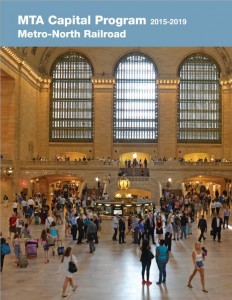 More than 275,000 daily commuters on Metro-North received good news in the MTA’s newly-released 2015-2019 Capital Program: the agency is moving forward with Penn Station Access, a $743 million project which has spent decades on the drafting table. Benefits of Penn Station Access include:
More than 275,000 daily commuters on Metro-North received good news in the MTA’s newly-released 2015-2019 Capital Program: the agency is moving forward with Penn Station Access, a $743 million project which has spent decades on the drafting table. Benefits of Penn Station Access include:
- a one-seat ride with substantially reduced travel times to Manhattan’s west side for New Haven Line customers
- expanded job access for Manhattan’s growing west side and more options for New York’s growing population of reverse commuters
- improved capacity and tri-state connectivity, improving links between Metro-North, LIRR, New Jersey Transit and Amtrak
- cost-effective use of existing tracks, and no new tunnels
- four new stations in under-served Bronx neighborhoods expanding transit options and economic and residential development near Co-op City, Morris Park, Parkchester and Hunts Point
This new service can’t begin until after completion of the $10.2 billion East Side Access, which will free up track space at Penn Station. Once complete, it will alleviate congestion at Mott Haven Junction, a system bottleneck where the Hudson, Harlem, and New Haven Lines all converge.
And in addition to service enhancements, the project will also bolster the transportation system’s resiliency for extreme weather events like Superstorm Sandy. Mott Haven Junction, for example, is particularly prone to flooding so increasing redundancy between Manhattan and points north a key fix that can’t be built soon enough.
Commuters using the Pascack Valley and Port Jervis lines from Rockland and Orange Counties into New Jersey (and vice versa) should benefit from investments to track, viaducts, bridges and station rehabilitations at Spring Valley, Middletown and Harriman. It is unclear if such investments on the Pascack Valley Line capture specific infrastructure improvements, such as full double-tracking and passing sidings, recommended by the Mass transit Task Force in its final report.
Also unclear is what MTA investments might be forthcoming in preparation for the 2018 launch of the new bus system serving the I-287/TZB corridor, although the Program mentions “potential intermodal improvements” for commuters going north into White Plains on the Harlem Line. White Plains, a key transportation hub in Westchester County, received a $1 million grant for the redevelopment of its transit hub into a multi-modal transportation center. This grant will help the City handle increasing reverse MNR ridership and prepare for new riders using the future bus system. A commitment of funds for the White Plains MNR station in the CP would support additional improvements and further position the station as a key cog in the region’s transit network.
Total investment for Metro-North over the next five years will be $2.6 billion, 85 percent of which is slated for state of good repair projects and maintaining existing assets. Other improvements include:
- updating the signal system with “Positive Train Control”
- replacement of aging M-3 commuter rail trains with M-8 cars with regenerative braking systems
- modernization of the 100+ year-old Harmon Shop to reduce energy consumption and enable an expanded fleet of rail cars
- installation of new track, realignment of existing track and replacement of railroad bridges to accommodate more trains
- customer service improvements such as real-time train information, investments in the new fare payment system and an improved public address system
- safety and security enhancements at all stations east of the Hudson River
The numbers in this Capital Program are tough to get one’s head around: $32 billion is needed to protect and improve $1 trillion worth of assets. But, as MTA Chairman Tom Prendergast said in the document’s opening preamble, we’re talking about a region that generates 11 percent of our nation’s gross domestic product.

It would be nice if MNR could also expand service on the Harlem Line in the Bronx to match what lower Westchester gets. More and more people are taking MNR from the Bronx – both north and south. It’s ridiculous that on Saturdays, train stations like Woodlawn only get hourly service, while places like Crestwood get service every half-hour. Bronx neighborhoods – particularly those not walking distance to a subway – would really benefit from having the same service that everybody else gets.
Penn Station Access originally included MetroNorth Hudson Line trains running down the west side of Manhattan with stops at 125th Street, 57th/59th Street and then Penn Station.
This part of the original vision opened up all sorts of possibilities:
* better access to points north for reverse commuters, and to the growing Manhattanville campus of Columbia University http://neighbors.columbia.edu/pages/manplanning/proposed_plan/PhasedDevelopment.html
* a link to a future Bus Rapid Transit line along 57th Street, alleviating the current two subway ride from Grand Central to this part of midtown
[…] Tri-State Outlines Metro-North Capital Plan Projects, Including Penn Station Access […]
[…] Tri-State Outlines Metro-North Capital Plan Projects, Including Penn Station Access […]
[…] Program so that Metro-North riders can be ensured safe, reliable service in the future. Nearly $3 billion of the five-year Program is slated for Metro-North […]
[…] the Hell Gate Bridge and the East River Tunnels. The idea garnered particular attention when it was included in the 2015-2019 MTA Capital Program, then singled out–in distinct contrast to the rest of the MTA’s capital […]
[…] capital funding in the 2015-16 state budget, it is still years from scheduled completion because it cannot be implemented until some Long Island Rail Road trains are diverted to Grand Central. But with more delays […]